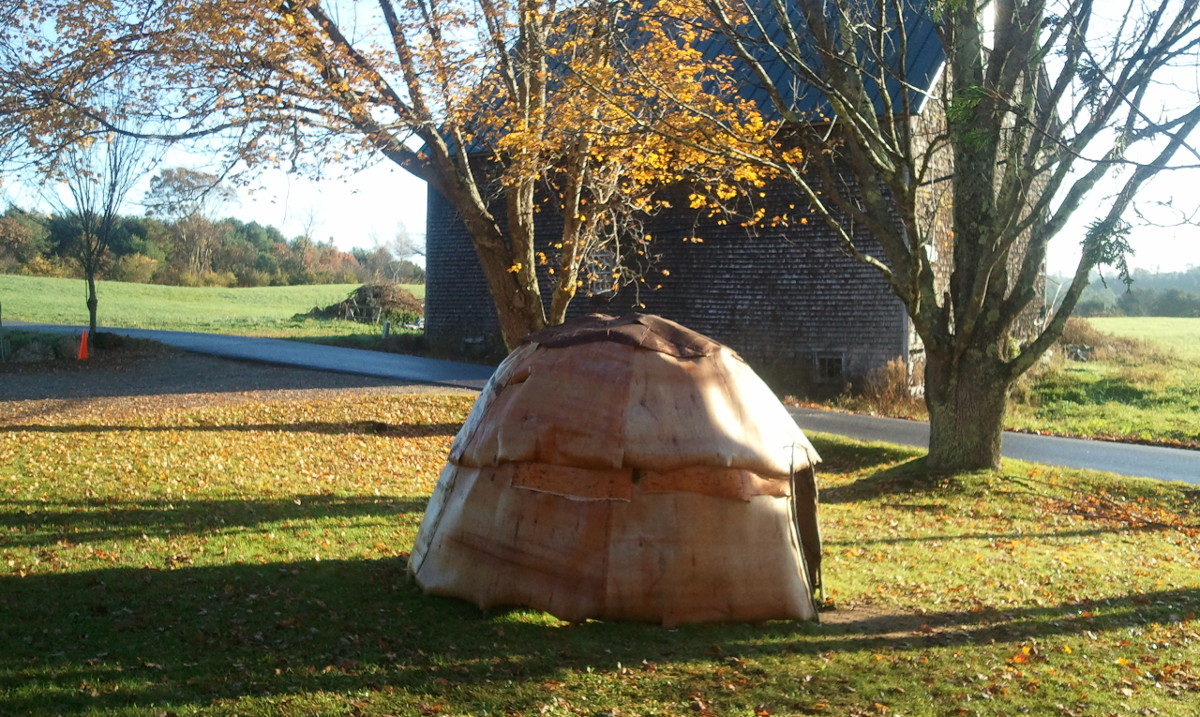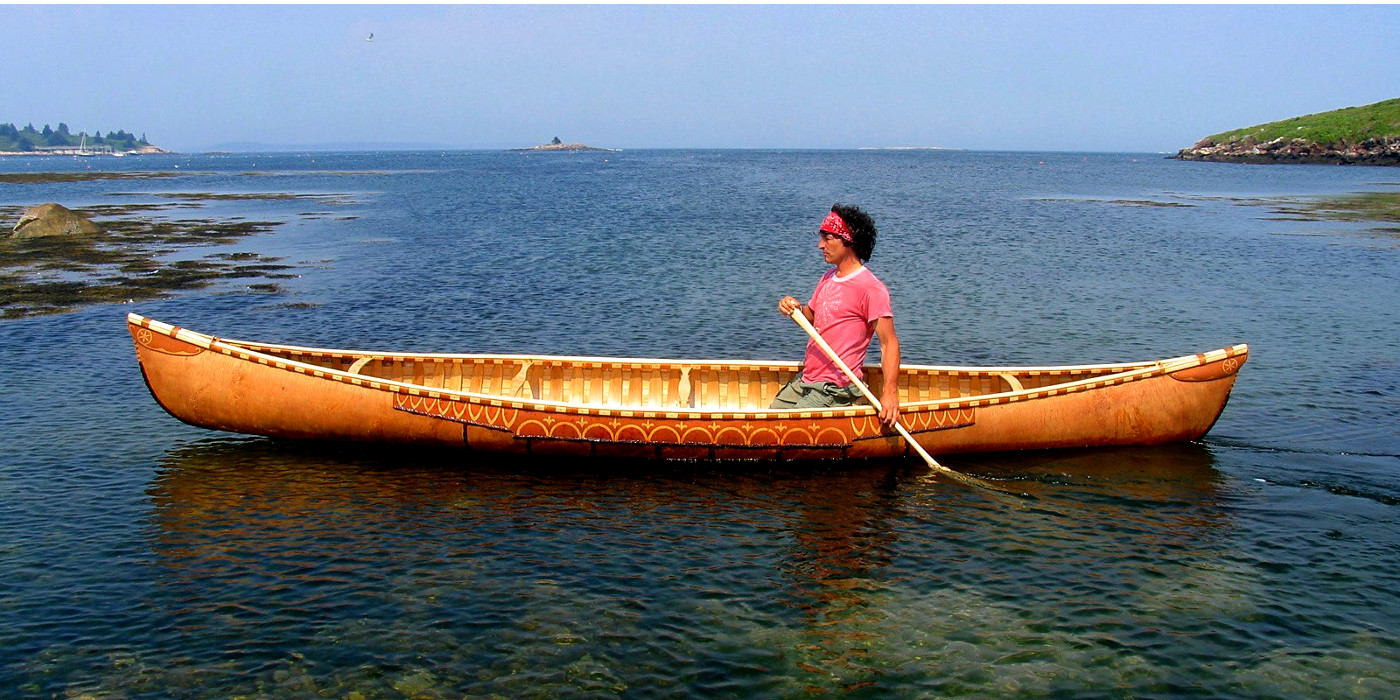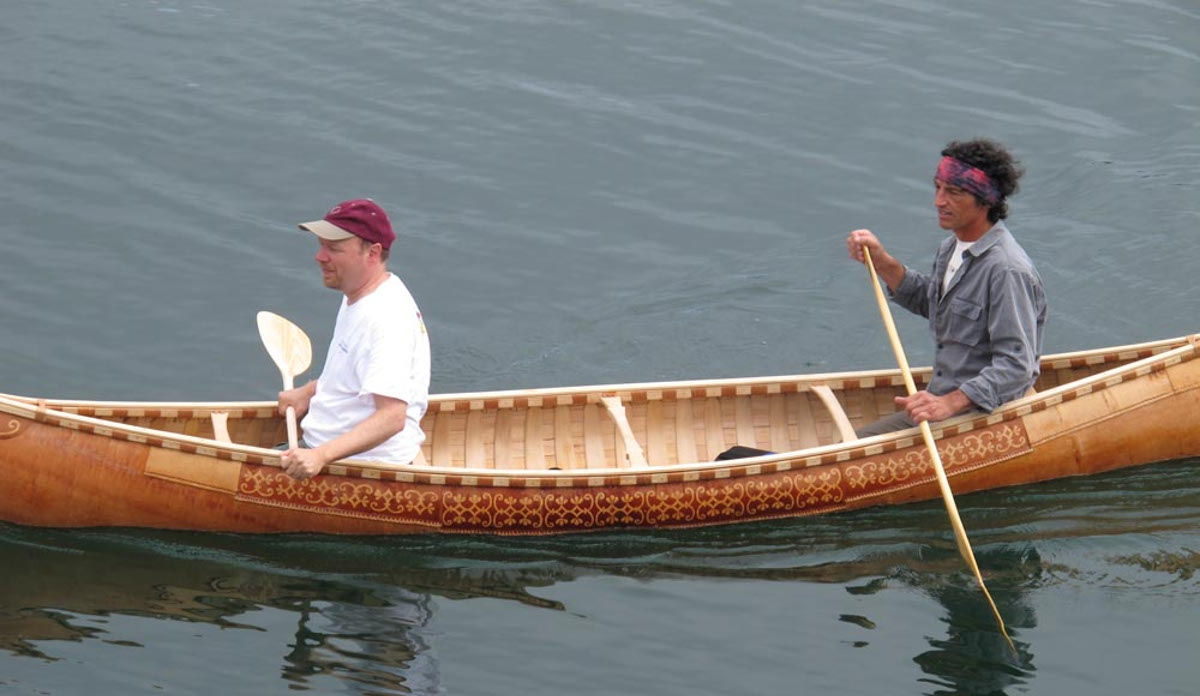Over thousands of years of living and traveling on the ocean, rivers and lakes known today as Maine, the Wabanaki tribes Passamaquody, Penobscot, Maliseet and Micmac) developed highly refine perfectly adapted birchbark canoes for this area.
David throughout his youth; even during his years in San Francisco, California never forgot his dream to become a canoe maker. It was only in the 90s, upon his return to Maine, that he began to build birch bark canoes. As his grandfather was already old at the time and couldn’t teach him directly, David studied naval architecture in Eastport and majored in history at the University of Maine in Machias. His studies and work with Steve Cayard, a respected self-taught canoe builder, were fundamental in his process of becoming a canoe maker. After years of learning and working with Steve, David achieved mastery in the field. Later, David and Steve led countless projects together to build Wabanaki full sizes canoes in the United States and Canada, as well as to restore ethnographic canoes in different museum collections including the National Museum of the American Indian and the Peabody Museum at Harvard University. Their canoe workshops lasted a month and encouraged a participative approach since everybody could collaborate directly in the construction process. David always described his journey to become a canoe maker as a spiritual search, through which he learned to value even more the legacy of his grandparents and ancestors. According to him, every time he walked through the woods looking for birch bark, he felt that he was walking the same steps as his ancestors, who for thousands of years had understood how to survive in an extreme environment like Maine.
Unlike his baskets and panels in which David innovated in shapes and designs, when he built canoes he chose not to innovate and faithfully follow the constructive process designed by his ancestors.
The ancestors figured it out a long time ago. When I built canoes today, I change nothing. The hull forms are specifics to their intended uses, whether they are for use on the ocean, lakes or rivers. That is the way I continued to build them today…Experimentation is an essential part of growing as an artist, but it is good to know when it passes from stylish or modern to silly and dysfunctional. I like to remind people that the ancestors did just fine for twelve thousands years. We are still here because of their knowledge and skills.
David’s words in the book The visual Language of Wabanaki,
written by Jeanne Morningstar Kent, 2014, pp. 121
David also built scale canoe models studying and being inspired by museum collections. His canoe models are part of museum and private collections like the Children Museum in Boston and the Wyeth, Kalenyan and Schwanfelder privates collections from Maine, Santa Fe and San Francisco.
Teaching Wabanaki subsistence skills, David built conical and domed shaped Wigwams (traditional homes or shelters) in museums, National Parks and educational centers like The Eiteljorg Museum, Acadia National Park and Damariscotta River Association.
For David, one of the most important parts of his job was the gathering of his own material:
“60 percent of this work is gathering. I spend up to two months of the year just gathering. Two weeks in April and another two weeks in late June or early July is just for gathering bark. When I search for roots and cedar, I spend another several weeks in the forest camping out. I gather my canoe bark from staring trees, so I spend a lot of time and energy climbing. You must be attuned to our ancestral homelands in order to see what the forest is offering. During those times, I am always walking with the ancestors. It is necessary to honor them because it is they who bring us closer to our imagery”
David’s words in the book The visual Language of Wabanaki,
written by Jeanne Morningstar Kent, 2014, pp. 122

Canoe and wigwam building Projects
| 2016, Damariscotta River Association: | David and Steve jointly prepare a project to built a 14-foot canoe. |
| 2016, Damariscotta River Association, Great Salt Bay Farm, Damariscotta, Maine: | David and Steve Cayard built an 11-foot conical birchbark wigwam. |
| 2015, Acadia National Park, Maine: | David built a domed shaped birchbark wigwam. |
| 2013, Abbe Museum: | David and Steve Cayard jointly built a 16-foot canoe for the Gala fundraising auction. |
| 2013, Abbe Museum: | David and Steve Cayard jointly built a 14-foot canoe built onsite at the Abbe for their educational programs. |
| 2011, Private Project (Gilbert Butler): | David and Steve Cayard jointly built a 16-foot canoe. |
| 2011, Passamaquoddy Tribe: | David and Steve Cayard co-led the building of a 20-1/2 foot ocean canoe, modeled on the 1868 Passamaquoddy canoe at the Maine State Museum. This project was organized by Donald Soctomah, and funded by the National Park Service. It was open to members of both Passamaquoddy communities, Motahkomikuk and Sipayik, and was held at the Wabanaki Culture Center in Calais. |
| 2010, Madawaska Maliseet First Nation, Edmundston, New Brunswick: | David and Steve Cayard co-led the building of an 18-foot canoe. |
| 2009 and 2010: Penobscot Marine Museum, Searsport: | David and Steve Cayard co-led two onsite building projects of two 16-foot canoes with a group of Wabanaki builders. |
| 2008 Eiteljorg Museum, Indianapolis: | David built a conical shaped birchbark wigwam. |
| 2007 Passamaquoddy Nation: | Cobscook Community Learning Center, Trescott, ME. |
| 2006 Allen Island: | Andrew and Betsy Wyeth canoe project, Muscongous Bay, ME. |
| 2006 Penobscot Marine Museum: | Searsport, ME. Canoe project and building of a conical wigwam. |
| 2004, St.Mary’s Maliseet First Nation, Fredericton, New Brunswick: | David and Steve Cayard co-led the building of an 18-foot canoe at the Wolastokwiyik Nawicowok Sacred Lands Trust, the project organized by Wayne Brooks and funded by the Canada Council for the Arts. |
| 2002-2005, Penobscot Indian Nation, Indian Island, Old Town, Maine: | In two projects David and Steve Cayard co-led in 2002 and 2003, two 18-foot canoe were built by community members. The second of these was funded by the Maine Arts Commission. A third, more extensive project, to gather all materials as a group and build a third 18-footer, funded by the National Park Service, was held over 13 weeks from 2003-2005; this was primarily Steve’s project, but David assisted toward the end. All three of these projects were organized by Chief Barry Dana. |
| 1998-2001, The Wooden Boat School, Brooklin, Maine: | David assisted Steve Cayard in teaching a week-long class each year. Each class built a 14-foot canoe. |
| 1999-2000, Maine Arts Commission: | David apprenticed with Steve Cayard, with some support from the MAC. David built an 18-foot canoe, with Steve’s help only in the early stages. David finished this canoe at Sipayik. |
| 1997, The WoodenBoat School, Brooklin, Maine: | David enrolled in Steve Cayard’s class as a student. |

Conservation, restauration and consultation
| 2015, Peabody Essex Museum, Salem, Massachusetts: David and Steve Cayard did research and gave consultation on their birchbark canoes. |
| 2014, Berkshire Museum, Pittsfield, Massachusetts: David and Steve Cayard repaired and conserved a circa 1900 Temagami Ojibway canoe, at Steve’s shop in Wellington, Maine. |
| 2011 Roosevelt Campobello International Park, Campobello, NB, Canada |
| 2011 Maine State Museum, Augusta ME. |
| 2009-10 Boston Children’s Museum, Boston MA. |
| 2009 Otter Island Films, Rockland ME. |
| 2001-2017 Abbe Museum, Bar Harbor, ME. |
| 2005 Penobscot Marine Museum, Searsport, ME. |
| 2000 Robert S. Peabody Museum, Salem, MA. |
| 1999 Mariners Museum, Newport News, VA. David, Steve Cayard and Darel Bridges (David’s brother), studied and consulted on the collection of scale canoe models made by Tappan Adney. |
| 1998 National Museum of the American Indian, Smithsonian Institution, Bronx, NY. Working with Marian Kaminitz, Director of Conservation, David and Steve Cayard assisted in repairs to a circa 1900 18-foot Passamaquoddy canoe built by Tomah Joseph. |

